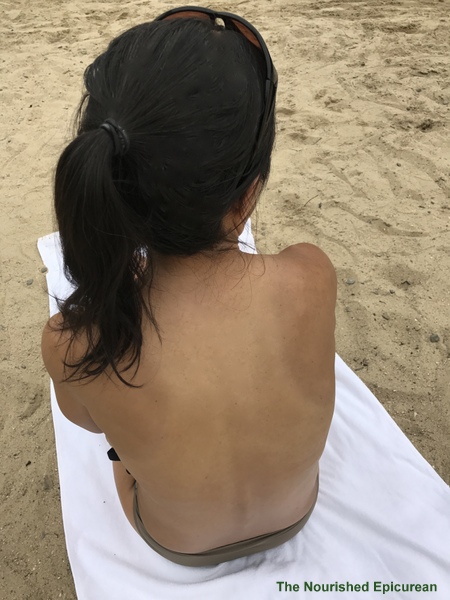♦ Does acne, hyper-pigmented skin, or a growing network of fine lines and wrinkles have you avoiding mirrors?!
♦ Are you constantly spending money on skin care products that promise a smooth, flawless complexion?
♦ Do you dread summer because, while everyone else is showing more skin, you suffer from itchy flares and unsightly patches of eczema, hives or psoriasis?
♦ Do you feel frustrated that the topical creams and antibiotics prescribed by your dermatologist have minimal to zero effect in eradicating persistent acne? And, even if your skin does clear somewhat, the acne always returns?
I’ve been there, too—searching out the guru dermatologists and chasing hope in a (pill) bottle.
Not only are pimples, itchy rashes, hives, fine lines and other unsightly skin conditions confidence crushers, they can seemingly take on a life of their own. The good news? By understanding the role of inflammation and the food-skin connection, you can start eating your way to healthy, glowing skin.
My acne story
I was a 22-year-old college graduate, who had lived in New York City for just nine months, when a purple scythe of inflamed acne suddenly appeared along the left side of my face. Dismayed, I tried a mountain of acne products—nothing worked. I consulted several dermatologists; the creams and antibiotics they prescribed had absolutely no effect. The heavy foundation that I carefully applied failed to conceal those angry pustules. With my “scarface”, I felt disfigured and exceedingly self-conscious. My self-confidence plummeted to zero.
Finally, I saw a dermatologist who gave a diagnosis: “acne vulgaris”. She prescribed an industrial strength dose of Accutane (recalled in 2009 for increased risk of birth defects and miscarriages; irritable bowel disease; and suicidal tendencies) for six months. I cheerfully endured the side effects—excessively dry skin; peeling, chapped lips; constant thirst; constipation and shedding skin like a snake. After five months, I had to stop taking Accutane because the side effects became intolerable. But I didn’t care. The impossible had happened…I had clear skin.
Yet…after receiving the gift of clear skin—thanks to Accutane—I still experienced periodic acne flares, including cystic acne. Accutane had not vanquished the root cause of my acne: inflammation.
Like my dermatologist back then, many dermatologists today will still tell you that there is no relationship between diet and acne.
Not Dr. Trevor Cates.
“What you eat can have a big effect on your skin,” writes Dr. Trevor Cates, a Park City, Utah-based naturopathic doctor (famously known as “The Spa Dr.”), in her book Clear Skin from Within.1 Yes, it is important to use non-toxic cosmetics and personal care products, and dermatological treatments have their place, but Cates says that achieving healthy skin is 80% “from within”—our diet (and lifestyle).
This is because the foods you eat can fuel—or calm—inflammation.
How inflammation affects your skin
A root cause of any skin condition is inflammation.
Inflammation can be “good”, activating our immune system to help heal a wound or to fight off harmful bacteria.
However, an overactive immune system that is always “on”—also known as chronic inflammation—can make us sick, leading to allergies, obesity, type 2 diabetes and heart disease.
Chronic inflammation can also lead to what Cates calls “skinflammation”—inflammation of the skin. Skinflammation triggers can be external or internal.
External triggers are substances that our skin absorbs and can cause oxidative stress, a process caused by unstable molecules that can damage cells throughout our body: UV rays from sunlight, cigarette smoke, pollutants, allergens and chemicals in soaps, detergents, cosmetics or personal care products. Poor sleep also causes oxidative stress.
Inflammation can be created inside the body, too. When your immune system perceives “foreign invaders”, such as viruses, toxins, foods to which you are allergic, sensitive or intolerant, even medications, it releases histamine, leading to inflammation that can manifest as acne, hives, eczema, rosacea, psoriasis or other skin conditions.
Looking back, I now understand that my severe acne vulgaris resulted from the cumulative effects of external and internal inflammation. The summer before moving to New York, I had experienced blistering sun poisoning on my face (oxidative damage). This was followed a highly stressful life transition, where, as an unpaid student intern at a major New York City cosmetics company, I worked long hours and subsisted on deli sandwiches, cheap Chinese takeout, and a pint of Häagen Dazs (all pro-inflammatory foods) most nights before falling, exhausted, into bed.
Hormones, stress, food sensitivities…and your skin
Many dermatologists will tell you that hormonal imbalances and/or stress cause acne or other skin conditions. While this is true, your diet plays an important role in influencing hormones, like testosterone, IGF-1 (insulin-like growth hormone), and insulin, which promote acne. Stress typically leads to poor food choices…remember: as a stressed out student intern, I was reaching for ice cream at end-day—not steamed broccoli!
Often, the foods for which we have insatiable cravings, or eat every single day, are those foods to which we likely have a food sensitivity or intolerance. Food allergies, sensitivities or intolerances = INFLAMMATION. This is often a root cause of acne and other skin conditions. Eating foods to which you have an allergy, sensitivity or intolerance creates internal stress and inflammation in the body. Over time, these foods create tears in the intestinal barrier, causing it to become permeable, also known as “leaky gut syndrome”. A leaky gut enables large protein molecules to escape into the bloodstream (where they don’t belong) and trigger an immune response in other organs and tissues, including the skin. Voila…acne, rosacea and hives!
Reducing skinflammation on the inside involves two steps: 1) Removing reactive foods (those foods to which you are sensitive or intolerant) and 2) Adding nutrient-dense foods that nourish your skin.
The top 3 foods that sabotage your skin
1. Sugar
When you eat lots of sugar (sweet and starchy foods), and that sugar is not being used immediately for energy, having excess glucose in your body will raise insulin levels.2 This, in turn, increases testosterone and overall inflammation, as well as sebum production (sebum is an oily substance that can trap bacteria), causing acne. A 2011 meta analysis study shows a strong association between high-glycemic load diets (processed foods, refined sugars) and acne vulgaris.3 A high sugar diet raises your blood sugar, reduces the elasticity of your skin and quality of collagen, making your skin thinner and more wrinkly. If you have high blood sugar, a Netherlands study found, other people perceive you as looking “older”!4
2. Dairy
Studies have linked milk consumption to acne. Why? Because dairy contains hormones—even if you buy milk that is organic or claims “no added hormones”. The majority of milk and dairy products in the U.S. come from pregnant cows, exposing consumers to the hormones that cows produce when they’re pregnant, like growth hormone and prolactin that can trigger acne. Milk is also naturally high in sugar (lactose), which can increase blood sugar, promoting the production of testosterone and sebum, which cause acne. Dairy foods—milk, cream cheese, cottage cheese, breakfast drinks and, especially, skim milk—are associated with an increase in acne vulgaris in adolescent girls.5
3. Wheat / Gluten-containing grains (eg, spelt, barley, rye, faro, oats)
You don’t have to have Celiac Disease to be reactive to gluten. As Cates points out in her book, “Gluten is one of the top allergenic foods that contribute to skinflammation issues. Some people erupt with exposure to just a dusting of flour, while other people’s skin problems emerge when gluten is consumed in excess.” Recent studies show supporting evidence that inflammatory skin diseases, like psoriasis, chronic hives and vitiligo, are linked to gluten intolerance and can improve on a gluten-free diet.6, 7
Best 6 Foods to feed a healthy complexion
According to Cates: “The most important foods to eat for clear, glowing skin are those rich in fatty acids, antioxidants, probiotics and prebiotics, collagen-boosting nutrients and detoxifying and anti-inflammatory properties.” These include8:
1. Vegetables. Aim for a minimum of 6 servings (1/2 cup raw; 1 cup cooked). High in antioxidants, vitamins, mineral and fiber, vegetables are essential for skin health, especially dark leafy greens (eg, romaine, Swiss chard, bok choy, baby lettuces, etc.). Vegetables from the brassica and cruciferous family (eg, Brussels sprouts, broccoli, kale, cauliflower, mustard greens, radishes, etc.) improve liver detoxification and have cancer-fighting properties.
2. High quality animal protein. 1 to 3 servings. 1 serving = 4 to 6 ounces. Amount varies, depending on gender, health status and activity level. Quality protein sources include wild caught fish (especially, wild-caught salmon), grass-fed beef, pasture-raised, free-range or organic chicken, pasture-raised pork and game, including buffalo (bison), elk, venison and boar, are quality sources of lean protein.
3. Filtered water. Drink half your body weight in ounces is what I typically recommend. This can vary depending on activity level, temperature (eg, hot and humid) and if you drink caffeine or alcohol, you need to drink more water.
4. Healthy Fats. 1 serving = 1 tablespoon. Good fats help nourish the skin cells. Wild-caught salmon is an excellent source of anti-inflammatory omega-3s. Olives and avocados, especially, are rich in monounsaturated fats and antioxidants, like vitamin E, to help fight oxidative damage. Skin-nourishing oils—coconut, avocado, sesame seed and olive—are rich in antioxidants and vitamins A and E; choose unrefined (or raw), cold-pressed oils.
If you are able to tolerate nuts and/or seeds), they can be a good source of essential fatty acids. Nuts are a common allergen. Those with autoimmune conditions, like Hashimoto’s, often have a sensitivity to nuts and seeds (like I do). Choose shelled nuts or plain, raw nuts or seeds—smell first as they can go rancid—and soak nuts and seeds for easier digestion.
5. Bone broth. Rich in minerals, collagen and gelatin, regular consumption of bone broth, made from the bones of grass-fed or organic animals, can help reduce fine lines and wrinkles. Click here for my bone broth recipe.
6. Smoothies. By adding greens, healthy fats and anti-inflammatory spices, smoothies can be a tasty way to nourish your skin. When adding fruit, choose low sugar fruits, like berries, apple and pear over sweeter, tropical fruits, like pineapple.
Since changing my diet several years ago, I have had clear, acne-free skin. On the rare occasion, a zit pops up, I can usually trace it back to a food sensitivity.
Non-toxic skin care
Externally, you want to protect your skin from oxidative damage with sunscreen. In my photo, I am swathed from head to toe in a high quality, UVA/UVB protective sunscreen, formulated with all natural ingredients and a physical sunblock (zinc oxide). Since the skin can absorb toxins, you will also want to choose the least toxic cosmetics and personal care products. An excellent resource that rates over 70,000 brands for safety the Environmental Working Group’s (EWG’s) Skin Deep Cosmetics Database.
Sources
1, 4, 8 Clear Skin from Within by Dr. Trevor Cates, 2017
2 Journal of Drugs in Dermatology, April 2014
3, 5 Cutis | MDedge, August, 2011, 88(2):84-91
4 AGE, February 2013
6 European Journal of Dermatology, Jan-Feb 2006
7 Gastroenterology Research and Practice, May 30, 2012


